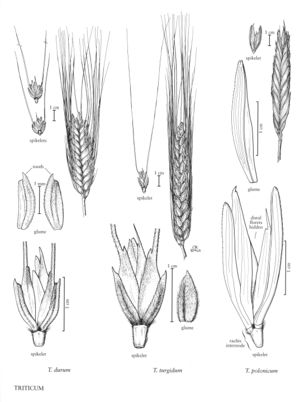Difference between revisions of "Triticum durum"
FNA>Volume Importer |
FNA>Volume Importer |
||
| Line 17: | Line 17: | ||
-->{{Treatment/Body | -->{{Treatment/Body | ||
|distribution=Alta.;Man.;Sask. | |distribution=Alta.;Man.;Sask. | ||
| − | |discussion=<p>Triticum durum is a domesticated spring wheat that is grown in temperate climates throughout the world. In the Flora region, it is grown in the Canadian prairies and northern Great Plains as a spring wheat, and in the southwestern United States and Mexico as a winter wheat. Triticum durum is typically used for macaroni-type pastas, semolina, and bulghur. Durum imparts a yellowish color to bread, and is the traditional wheat for flat breads and pita. Cultivars grown in the Flora region represent a minor sampling of the overall diversity in the species.</p><!-- | + | |discussion=<p><i>Triticum durum</i> is a domesticated spring wheat that is grown in temperate climates throughout the world. In the Flora region, it is grown in the Canadian prairies and northern Great Plains as a spring wheat, and in the southwestern United States and Mexico as a winter wheat. <i>Triticum durum</i> is typically used for macaroni-type pastas, semolina, and bulghur. Durum imparts a yellowish color to bread, and is the traditional wheat for flat breads and pita. Cultivars grown in the Flora region represent a minor sampling of the overall diversity in the species.</p><!-- |
| − | --><p>The commercial cultivar Kamut® is durum wheat. Grown in the Flora region and worldwide, it encompasses a variable collection of forms. Kamut® has also been identified as Triticum turanicum Jakubz. (a durum-like wheat from Iran) or T. polonicum, although its presumed Egyptian origin and spike morphology do not agree with the original concept of these species.</p> | + | --><p>The commercial cultivar Kamut® is durum wheat. Grown in the Flora region and worldwide, it encompasses a variable collection of forms. Kamut® has also been identified as <i>Triticum</i> turanicum Jakubz. (a durum-like wheat from Iran) or <i>T. polonicum</i>, although its presumed Egyptian origin and spike morphology do not agree with the original concept of these species.</p> |
|tables= | |tables= | ||
|references= | |references= | ||
| Line 39: | Line 39: | ||
|publication year= | |publication year= | ||
|special status= | |special status= | ||
| − | |source xml=https://jpend@bitbucket.org/aafc-mbb/fna-data-curation.git/src/ | + | |source xml=https://jpend@bitbucket.org/aafc-mbb/fna-data-curation.git/src/8f726806613d60c220dc4493de13607dd3150896/coarse_grained_fna_xml/V24/V24_390.xml |
|subfamily=Poaceae subfam. Pooideae | |subfamily=Poaceae subfam. Pooideae | ||
|tribe=Poaceae tribe Triticeae | |tribe=Poaceae tribe Triticeae | ||
Revision as of 16:19, 18 September 2019
Culms 60-160 cm; nodes glabrous; internodes mostly hollow, solid for 1 cm below the spikes. Blades 7-16 mm wide, usually glabrous. Spikes 4-11 cm, about as wide as thick, never branched; rachises ciliate to partially ciliate at the nodes and margins, not disarticulating; internodes 3-6 mm. Spikelets 10-15 mm, with 5-7 florets, 2-4 seed-forming. Glumes 8-12 mm, coriaceous, loosely appressed to the lower florets, with 1 prominent keel, terminating in a tooth, tooth to 0.3 cm; lemmas 10-12 mm, lower 2 lemmas awned, awns to 23 cm; paleas not splitting at maturity. Endosperm usually flinty, sometimes mealy. Haplomes AuB. 2n = 28.
Distribution
Alta., Man., Sask.
Discussion
Triticum durum is a domesticated spring wheat that is grown in temperate climates throughout the world. In the Flora region, it is grown in the Canadian prairies and northern Great Plains as a spring wheat, and in the southwestern United States and Mexico as a winter wheat. Triticum durum is typically used for macaroni-type pastas, semolina, and bulghur. Durum imparts a yellowish color to bread, and is the traditional wheat for flat breads and pita. Cultivars grown in the Flora region represent a minor sampling of the overall diversity in the species.
The commercial cultivar Kamut® is durum wheat. Grown in the Flora region and worldwide, it encompasses a variable collection of forms. Kamut® has also been identified as Triticum turanicum Jakubz. (a durum-like wheat from Iran) or T. polonicum, although its presumed Egyptian origin and spike morphology do not agree with the original concept of these species.
Selected References
None.
